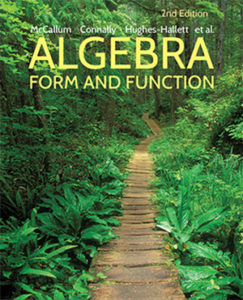
Algebra: Form and Function, 2nd Edition
By William G. McCallum, Eric Connally, Deborah Hughes-Hallett
Algebra: Form and Function, 2nd Edition by McCallum, Connally, and Hughes-Hallett offers a fresh approach to algebra by focusing on the underlying structure and principles behind the symbolic representation of complex ideas.
WileyPLUS is a research-based, online environment for effective teaching and learning. WileyPLUS is packed with interactive study tools and resources—including the complete e-textbook—to give students more value for their money.
Schedule a Demo Sign Up for a Test Drive Adopt WileyPLUSWant to learn more about WileyPLUS? Click Here
A balanced approach
This program helps students develop fluency in the language of algebra, including an ability to recognize algebraic form and understand the purpose of different forms, through unique examples and exercises.
Restoring meaning to expressions and equations
After introducing each type of function—linear, power, quadratic, exponential, polynomial—this program encourages students to examine the basic forms of expressions for that function, see how they are constructed, and consider the different properties of a function that the different forms reveal.
Maintaining manipulative skills
The rules of algebra and the reasons for these rules are reviewed throughout. Numerous exercises to reinforce skills are presented in each chapter, and a section of drill problems on solving equations is found at the end of the chapters on linear, power, and quadratic functions.
Students with varying backgrounds
The content is thought provoking for well-prepared students while still accessible to students with weaker backgrounds, reaching students of all ability levels.
WileyPLUS with ORION
Based on cognitive science, WileyPLUS with ORION provides students with a personalized, adaptive learning experience so they can build their proficiency on topics and use study time most effectively.
- A Balanced Approach: Form, Function, and Fluency. To use algebra in later courses, students need not only manipulative skill, but fluency in the language of algebra, including an ability to recognize algebraic form and an understanding of the purpose of different forms. Algebra achieves this through unique examples and exercises.
- Restoring Meaning to Expressions and Equations. After introducing each type of function–linear, power, quadratic, exponential, polynomial–the text encourages students to pause and examine the basic forms of expressions for that function, see how they are constructed, and consider the different properties of the function that the different forms reveal.
- Maintaining Manipulative Skills: Review and Practice. Acquiring the skills to perform basic algebraic manipulations is as important as recognizing algebraic forms. Algebra: Form and Functionprovides sections reviewing the rules of algebra, and the reasons for them, throughout the book, numerous exercises to reinforce skills in each chapter, and a section of drill problems on solving equations at the end of the chapters on linear, power, and quadratic functions.
- Students with Varying Backgrounds. Algebra: Form and Function is thought-provoking for well-prepared students while still accessible to students with weaker backgrounds, making it understandable to students of all ability levels.
What’s New
WileyPLUS is a research-based online environment for effective teaching and learning. WileyPLUS is packed with interactive study tools and resources–including the complete online textbook–to give your students more value for their money. With WileyPLUS, students will succeed in College Algebra
William G. McCallum is a University Distinguished Professor of Mathematics and Head of the Department of Mathematics at the University of Arizona. Born in Sydney, Australia in 1956, he received his Ph.D. in Mathematics from Harvard University in 1984, under the supervision of Barry Mazur. After spending two years at the University of California, Berkeley, and one at the Mathematical Sciences Research Institute in Berkeley, he joined the faculty at the University of Arizona in 1987. In 1989 he joined the Harvard calculus consortium, and is the lead author of the consortium’s multivariable calculus and college algebra texts. In 1993-94 he spent a year at the Institut des Hautes Etudes Scientifiques, and in 1995-96 he spent a year at the Institute for Advanced Study on a Centennial Fellowship from the American Mathematical Society. In 2005 he received the Director’s Award for Distinguished Teaching Scholars from the National Science Foundation. In 2006 he founded the Institute for Mathematics and Education at the University of Arizona. He was Director of the Institute until 2009 and now chairs its advisory board. In 2009-2010 he led the work team that developed the NGA/CCSSO Common Core Math Standards. His professional interests include arithmetical algebraic geometry and mathematics education.
Chapter 1: Functions and Algebraic Structure
Chapter 2: Linear Functions
Chapter 3: Quadratic Functions
Chapter 4: Power Functions
Chapter 5: More on Functions
Chapter 6: Exponential Functions
Chapter 7: Logarithms
Chapter 8: Polynomial Functions
Chapter 9: Rational Functions
Appendix A: Expressions
Appendix B: Equations
Appendix C: Inequalities
Appendix D: Quadratics
Appendix E: Algebraic Fractions
Appendix F: Absolute Value
Appendix G: Exponents
Chapter 10 Summation Notation (Online Only)
Chapter 11 Sequences and Series (Online Only)

